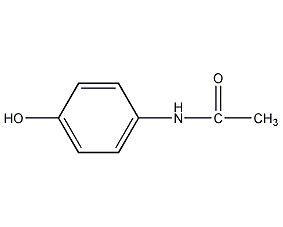p-Hydroxyacetanilide p-Hydroxyacetanilide


Structural formula
| Business number | 02PG |
|---|---|
| Molecular formula | C8H9NO2 |
| Molecular weight | 151.16 |
| label |
Parahydroxyacetanilide, Acetaminophen, paracetamol, N-acetyl para-aminophenol, N-(4-hydroxyphenyl)acetamide, acetaminophen, p-Hydroxyphenylacetamide, Acetaminophen, 4-Acetamidophenol, 4-Acetaminophenol, 4′-Hydroxyacetanilide, 4-Hydroxyacetanilide, 4-(Acetylamino)phenol, Acetaminophen, Acetyl-p-aminophenol, Akosbbs-00008094 |
Numbering system
CAS number:103-90-2
MDL number:MFCD00002328
EINECS number:203-157-5
RTECS number:AE4200000
BRN number:2208089
PubChem number:24891173
Physical property data
1. Properties: Colorless monorhombic prism crystals. Odorless. Bitter taste.
2. Density (g/mL, 25/4℃): 1.293
3. Relative vapor density (g/mL, air=1): Undetermined
4. Melting point (ºC): 169-170
5. Boiling point (ºC, normal pressure): Undetermined
6. Boiling point (ºC, 5.2kPa): Undetermined Determined
7. Refractive index: Undetermined
8. Flash point (ºC): Undetermined
9. Specific rotation (º): Undetermined
10. Autoignition point or ignition temperature (ºC): Undetermined
11. Vapor pressure (kPa, 25ºC): Undetermined
12. Saturation Vapor pressure (kPa, 60ºC): Undetermined
13. Heat of combustion (KJ/mol): Undetermined
14. Critical temperature (ºC): Undetermined
15. Critical pressure (KPa): Undetermined
16. Log value of oil-water (octanol/water) partition coefficient: Undetermined
17. Explosion upper limit (% , V/V): Undetermined
18. Lower explosion limit (%, V/V): Undetermined
19. Solubility: Soluble in methanol, ethanol, dichloroethylene , acetone and ethyl acetate, slightly soluble in ether and hot water, almost insoluble in cold water, insoluble in petroleum ether, pentane and benzene.
Toxicological data
The median lethal dose (rat, oral) 338 mg/kg.
Ecological data
It is extremely harmful to water and toxic to fish. Do not let the product enter the water body.
Molecular structure data
1. Molar refractive index: 42.40
2. Molar volume (cm3/mol): 120.9
3. Isotonic specific volume (90.2K ): 326.0
4. Surface tension (dyne/cm): 52.8
5. Dielectric constant:
6. Dipole moment (10-24cm3):
7. Polarizability: 16.81
Compute chemical data
1. Reference value for hydrophobic parameter calculation (XlogP): None
2. Number of hydrogen bond donors: 2
3. Number of hydrogen bond acceptors: 2
4. Number of rotatable chemical bonds: 1
5. Number of tautomers: 6
6. Topological molecule polar surface area 49.3
7. Number of heavy atoms: 11
8. Surface charge: 0
9. Complexity: 139
10. Number of isotope atoms: 0
11. Determine the number of atomic stereocenters: 0
12. Uncertain number of atomic stereocenters: 0
13. Determine the number of chemical bond stereocenters: 0
14. Number of uncertain chemical bond stereocenters: 0
15. Number of covalent bond units: 1
Properties and stability
1. Avoid contact with oxides.
2. Toxic and irritating, avoid contact with eyes and skin when using.
Storage method
1. Store in a cool, ventilated warehouse. Keep away from fire and heat sources. Keep container tightly sealed. should be kept away from oxidizer, do not store together. Equipped with the appropriate variety and quantity of fire equipment. Suitable materials should be available in the storage area to contain spills.
Synthesis method
Originated from acetylation of para-aminophenol. Method 1: Add para-aminophenol to dilute acetic acid, then add glacial acetic acid, raise the temperature to 150°C and react for 7 hours, add acetic anhydride, react for another 2 hours, check the end point, cool to below 25°C after passing the test, filter, and wash with water until no acetate is present. Sour, spin dry to get crude product. Method 2: Distill paraaminophenol, glacial acetic acid and the acid mother liquor containing more than 50% acid together. The dilute acid is evaporated at a rate of one-tenth of the total amount distilled per hour. When the internal temperature rises to above 130°C, Take a sample to check that the residual amount of para-aminophenol is less than 2.5%, add dilute acid (content is more than 50%), and cool to crystallize. Filter, first wash with a small amount of dilute acid, and then wash with a large amount of water until the filtrate is close to colorless to obtain a crude product. The yield of method 1 is 90%, and the yield of method 2 is 90-95%. Refining method: Add the crude product when the water is heated to nearly boiling. Raise the temperature until it is completely dissolved, add activated carbon soaked in water, adjust to pH=4.2-4.6 with dilute acetic acid, and boil for 10 minutes. Press filter and add a small amount of sodium bisulfite to the filtrate. Cool to below 20°C to precipitate crystals. Filter, wash and dry to obtain the finished product of raw material paracetamol. Other production methods include: (1) reducing p-nitrophenol with zinc in glacial acetic acid and acetaminophen at the same time; (2) placing the hydrazone generated from p-hydroxyacetophenone in an acidic solution of sulfuric acid , add sodium nitrite, translocation generates acetaminophen.
Purpose
1. Drug intermediates. Manufacture of azo dyes. Photographic chemicals.